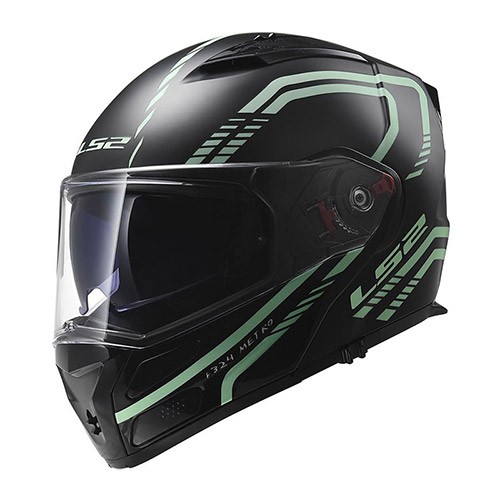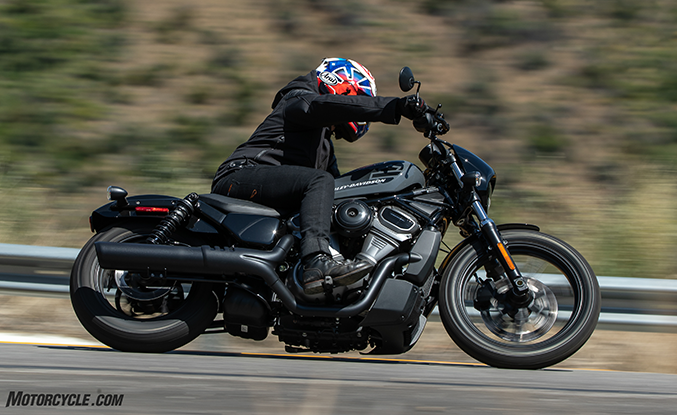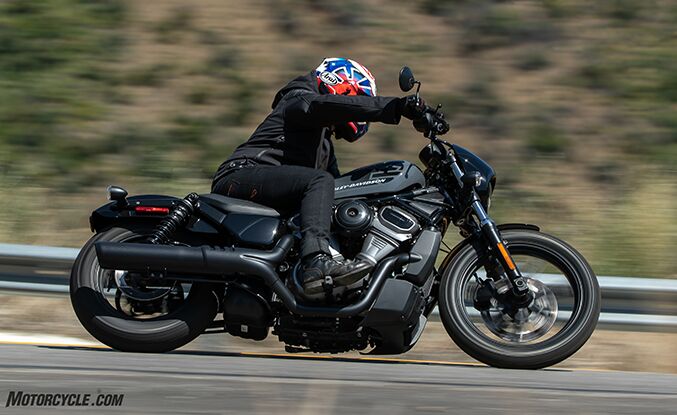
The Sportster hasn’t been all that sporty for some time now – that is aside from the 2021 Sportster S that the Nightster shares more than a handful of tricks with. It’s been 65 years since Harley-Davidson introduced the Sportster as America’s answer to the British invasion of bikes that had begun to increase in popularity Stateside around that time. Back then, folks used their motorcycles for everything – drags, trials, enduros, scrambles, hare and hounds, road runs, and Sunday cruising. You could do it all on a Harley according to the 1958 ad for the Sportster CH and C models below. The market wasn’t so segmented.
Modern performance in a classic Sportster configuration.
Editor Score: 81%
| Engine | 18/20 | Suspension | 12/15 | Transmission | 8/10 |
| Brakes | 8/10 | Instruments | 3/5 | Ergonomics | 8.5/10 |
| Appearance | 8/10 | Desirability | 8/10 | Value | 7.5/10 |
+ Highs
|
– Sighs
|
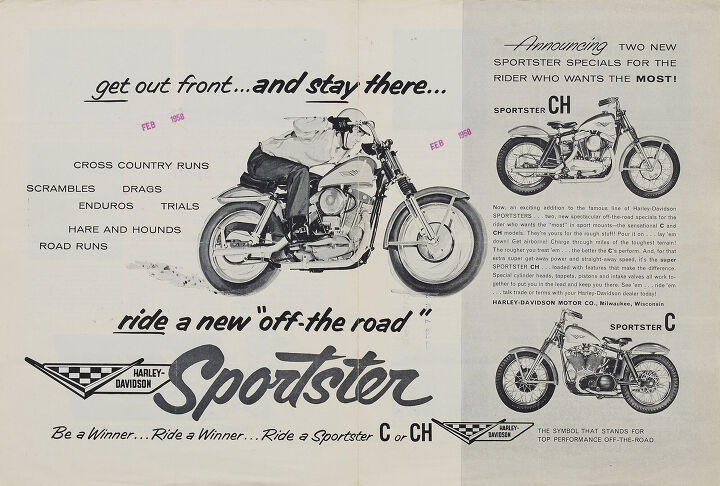
That is, of course, not to discredit the history the Sportster model has had in competition. While my 30-something-year-old view of the Sportster knows it as a platform for customizers and the gateway drug into the H-D fold, the dynamic character of the bike is the reason the Sportster line has been so popular since its inception. From enduros and drags of the late ’50s and ’60s, to the hooligan races of today and all of the customized machines along the way, the Sportster has been used in a myriad of ways by enthusiasts of every ilk. With the all-new Nightster, what we have now is a Sportster with some seriously modern sporting capability.

Attainable and easy to ride, with a high performance window
That was the goal for the 2022 Harley-Davidson Nightster. With a 27.8-inch seat height (unladen), a claimed wet weight of 481 pounds – most of which is tucked low on the bike – 90 hp, and 70 lb-ft of torque, it sounds like the folks from Milwaukee have put together a good formula for reaching that goal. It wasn’t easy, says VP of Design, Brad Richards. Keeping the classic Sportster DNA was a challenge with the new engine, and particularly so after the switch to using the engine as a stressed member of the chassis as opposed to the traditional “loop” frame Sportsters had been using since the beginning. A similar setup can be found on the Sportster S, but the Nightster was meant to match as closely as possible the silhouette of the Iron 883, so H-D had some work to do.
While we didn’t have an Iron 883 to verify the claim that the riding position and general stance of the bike was very similar, it was easy to see, and from the fancy graphic our man DC put together above, it’s fun to check out the similarities.
In development, the new Revolution Max engine itself was scrutinized for weight savings – seen here in the 975T variant, more on that later – but the Milwaukeeans also engineered weight savings and agility into the bike in other ways.
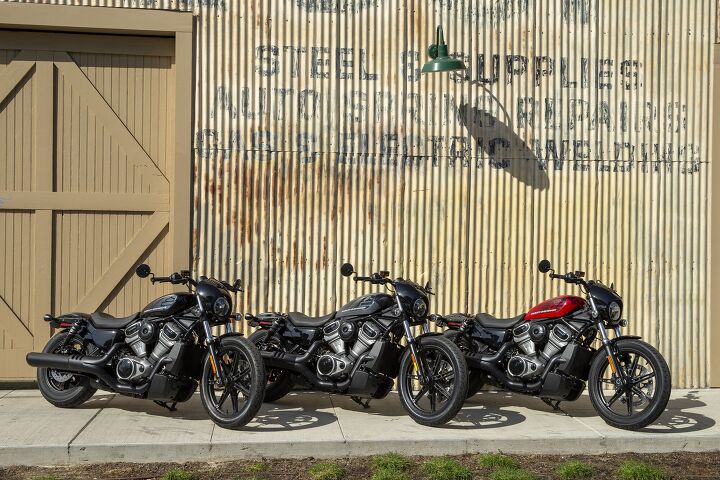
Aside from the expected Vivid Black and Gunship Grey, the Nightster can also be had in Redline Red. Units are currently arriving in dealerships.
The Nightster uses a Showa dual-shock suspension system out back with 3 inches(!) of travel adjustable for only spring preload (a skeletal spanner wrench for adjustment is included under the seat, also where you’ll find the fuel filler). Not only does this keep up the classic look, it freed up room under the 27.1-inch tall seat that would otherwise be taken up by a monoshock, so H-D tucked the Nightster’s 3.1 gallon fuel tank underneath, keeping its weight low in the chassis. So, what’s under that steel “almond-shaped” tank cover? You guessed it, the airbox, fed by an intake funnel that sucks air from the engine’s right side beneath a classic round Sportster-esque intake cover.
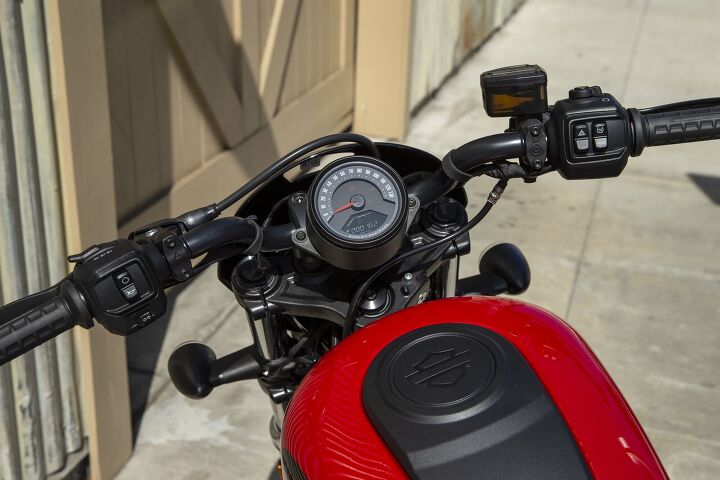
Where’s the tach? The cockpit is fairly barebones on the Nightster which was fine, but the buttons on the switch gear felt oddly placed and were difficult to access unless your hands were choked all the way up in the grips. I won’t bother whining about the lack of TFT. Some riders did find the gauge hard to read in direct sunlight though.
Harley reps admitted that the previous gen bikes, like the Iron 883, feel a bit top heavy. With the new setup you no longer feel like you’re lifting a solid chunk of lead off of the kickstand when you right the bike. Further acknowledging the previous heft, our presenters warned us to be careful not to put too much work into lifting the bike from its side stand or we might be headed to the other side quicker than expected. They weren’t kidding.
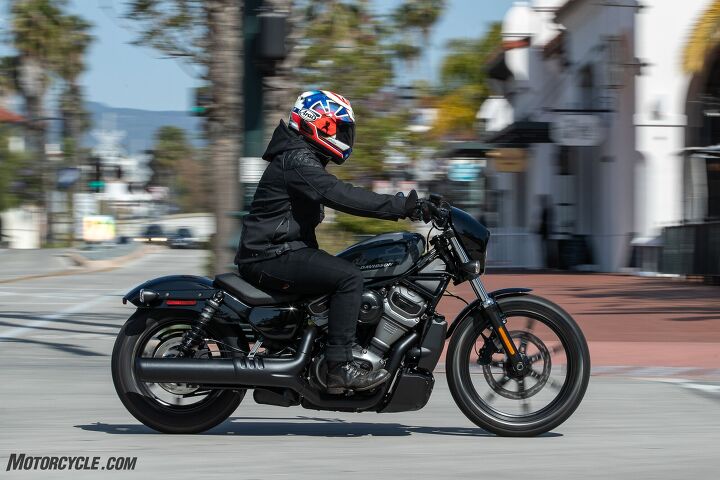
Ergonomically, the Nightster fit me quite well, as a guy with a 30-inch inseam and 5’8” stature. I might prefer bars that were a half-inch or so further back. When tearing up the canyons, one can just imagine a taller seat putting you into more of a naked bike riding position… maybe one day.
The Motor Co.
As we have been reporting since the Pan America hit the scene, the new Rev Max motor is a peach. In this 975cc T version, the story is much the same but first let’s take a look at how it differs from the Sportster S’s 1250T mill.
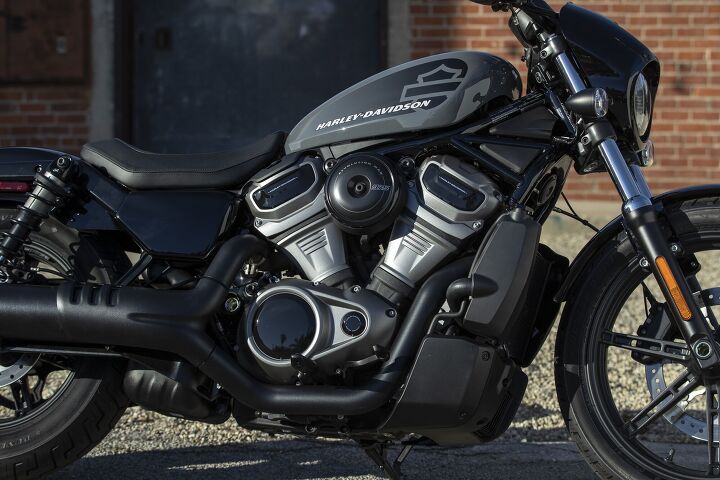
Single-piece aluminum cylinders with nickel silicon carbide-surface galvanic coatings are a lightweight design feature as are the magnesium rocker covers, camshaft covers and the primary cover.
To get down to the 975 cc displacement on the 60-degree V-Twin, Harley-Davidson has reduced both bore and stroke by 8mm and 6.3mm respectively. Despite the smaller bore and shorter stroke, the outside of the motor is the exact same size as the 1250T. The smaller bore, we’re told, needs only a single spark to fire efficiently, whereas the 1250 uses dual plugs per cylinder. Both the Nightster and Sportster S share the same 12:1 compression ratio in the T variant of the Rev Max engine, which is down slightly from the Pan America’s 13:1.
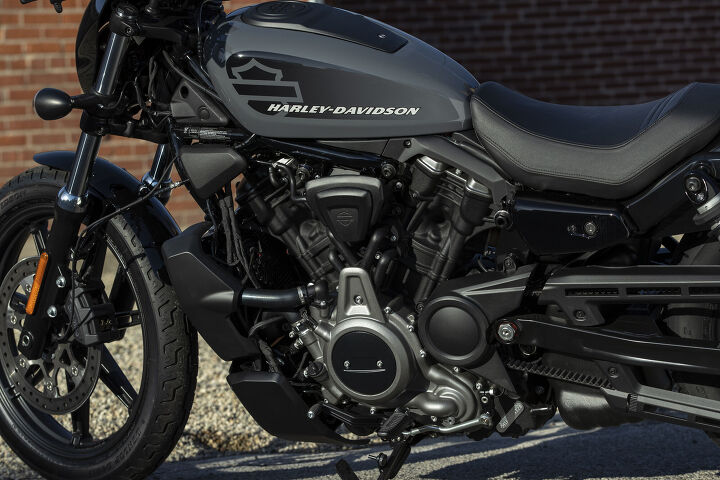
Not sure what to say about this side of the motor…
As with the previous iterations of the Rev Max, knock sensors are used should you find yourself blasting down to Baja and filling up your tank with gasoline from water bottles – or if you just decide gas has gotten so expensive that you refuse to fill up with the recommended 91 octane.
The same DOHC four-valve head design is used, but now we have variable valve timing only on the intake side. As we’ve said before, thank you Harley for the hydraulic valve lash adjusters that keep the valve train maintenance free. When the engine shuts down, the VVT system sets the intake cams back fully to reduce compression for easy starting – we did however have some issues with hard starting on our last Pan America that also utilizes the system – but I had no issues to report with the Nightster during our 100-mile press ride.
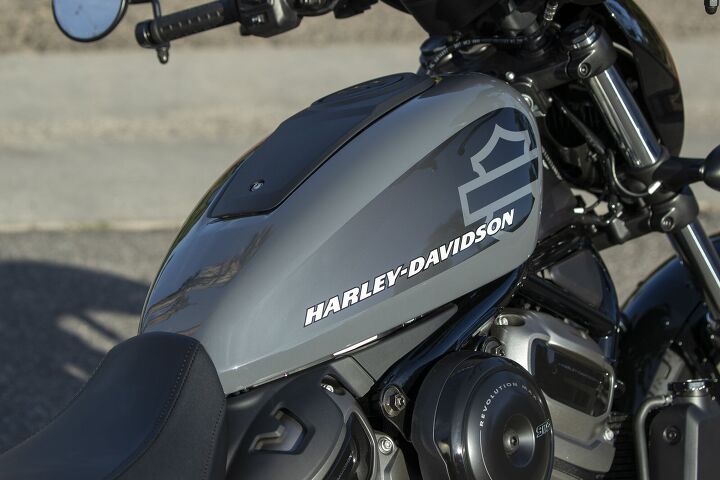
The steel tank cover looks nice, but the lack of bracing along the sides meant you could pretty easily push it in with your hand and if you flicked it, the sound brought to mind that of a bell tolling.
As mentioned previously, the 6.5-liter airbox sits under a steel cover where the iconic tank once sat, which feeds air down-draft style into two 50mm throttle bodies. The airbox’s shape itself has been tuned to quell resonance and muffle intake noise.
Again, not new to the Rev Max motor, but an impressive feature – the dual counterbalancers. This engine is incredibly smooth while cruising down the road. Harley describes them as such: A spiral-shaped, chain-driven primary balancer located in the crankcase manages the primary vibration created by the crank pins, pistons and connecting rods, and also a “rolling couple,” or side-to-side imbalance, caused by the off-set cylinders. A small secondary balancer located in the front cylinder head between the camshafts complements the primary balancer to further reduce vibration.
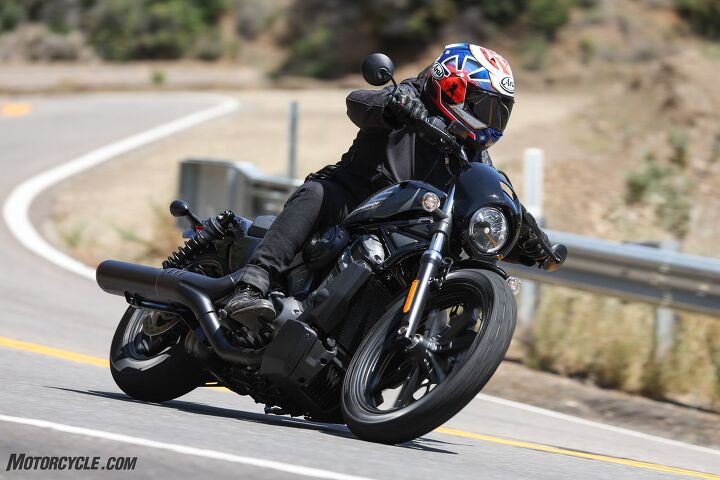
With all the work Harley-Davidson has done keeping the Nightster’s 481 pounds low in the machine, it handles much easier than the scales would suggest.
On the new Nightster, you have six gears to row through, with a cable actuated clutch. The six-speed transmission shift system features roller bearings to support the shift drum and Teflon-coated shift shaft support bushings to minimize frictional losses and optimize shift quality. The semi-dry transmission cavity should reduce parasitic power loss.
Sounds like a pretty modern package with some enticing pros, so were there any cons? We set off from our hotel in Santa Barbara, CA to find out.
Where the footpegs meet the road
Well, first we set off a mile down the road for some urban photos. That couple miles of riding around town was actually more telling than you might think. Taking off with the Nightster in Sport mode, I found the throttle to be a bit abrupt and although the lightweight motor spins up quick into its rowdy mid-range, it didn’t have that quintessential really low-end torque that we’ve come to love from V-Twins. It’s been a long while since I’ve been on a Sportster, 883 or otherwise, and I haven’t ridden the Sportster S. Still, my initial thought was that I expected more bottom end.
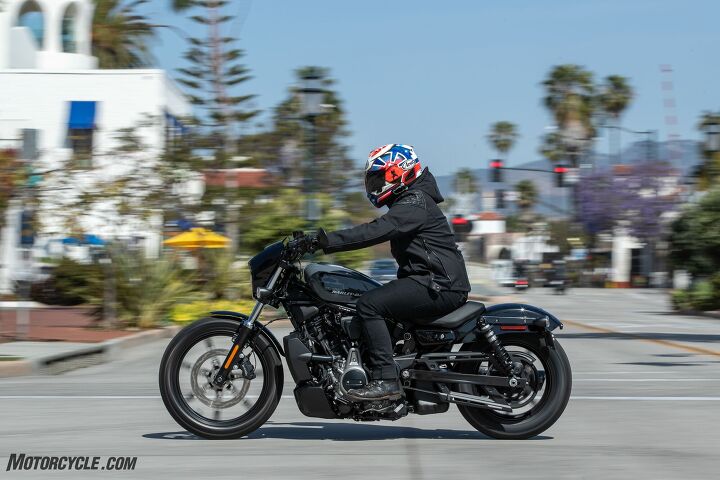
LED lighting can be found throughout.
I quickly switched to Road mode while we were cruising around town which helped smooth things out quite a bit, though some on/off throttle jerkiness prevailed. This seemed to be the ticket for general riding on the Nightster, but as soon as we got up into the hills and tight backroads stretched out into faster flowing ones, the train of at least the first four or so Nightsters I was trailing quickly sashayed through the canyons, wheel to wheel and sometimes side by side, confidently. The pace was good, perhaps representative of the average-to-fast Sportster riders out there, but the Nightster goads you into pushing the limits well past its claimed 32-degrees of lean angle with its raucous mid-range that pulls hard toward its 9500 rpm redline. That’s 500 more revs than the Sportster S. During our long photo passes we began filing down our footpegs – and boots in some cases. The footpegs aren’t any wider than they need to be.
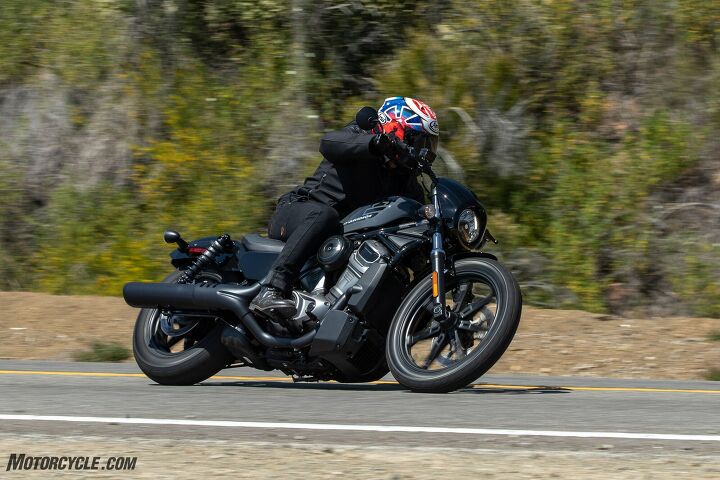
I can’t say that I wasn’t surprised by how much fun I managed to have on the Nightster despite its 19/16-inch wheel combo. The Dunlop D401s got the job done without stress and although I wouldn’t call the bike quick steering, it’s not all that slow considering.
The 975T Revolution Max engine has the same mid-range that I believe I’ve referred to as stonkin’ more than a few times already. Although the T is meant to differentiate that this is the torque-tuned version, the mid- to top-end power delivery, and unfortunately the lack of really low low-end reminded me of the PA’s engine character. Out in the canyons and into Sport mode, the Nightster cares not that it is a cruiser. The thing rips.
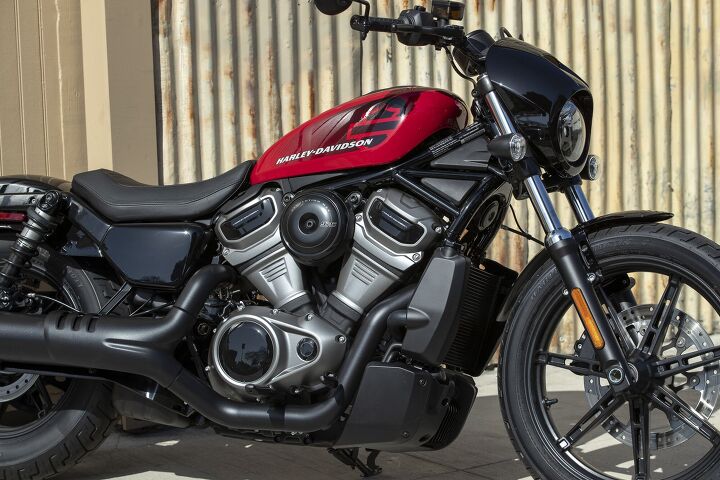
Despite your thighs nearly resting on the top of the rear cylinder, heat was never much of a concern during our ride, even when schlepping around town.
As you’ve well exceeded your 32 degrees of lean angle and the folding footpeg is giving way to your foot or hard parts you may not want to be dragging, the Nightster feels perfectly planted. The Showa suspension is on the stiff end of the spectrum as it only has three inches of travel in the rear and 4.5-inches up front to work with, but the damping is better than I remember on previous H-Ds. Sharp bumps will still attempt to compact your spine, but at least the mid-mount controls give you a chance of taking it on the foot instead of up your, ahem, rear end. Don’t forget, it was the Sportster’s predecessor, the K line which was the first Harley-Davidson to offer hydraulic suspension on both wheels. You’ve got to start somewhere.
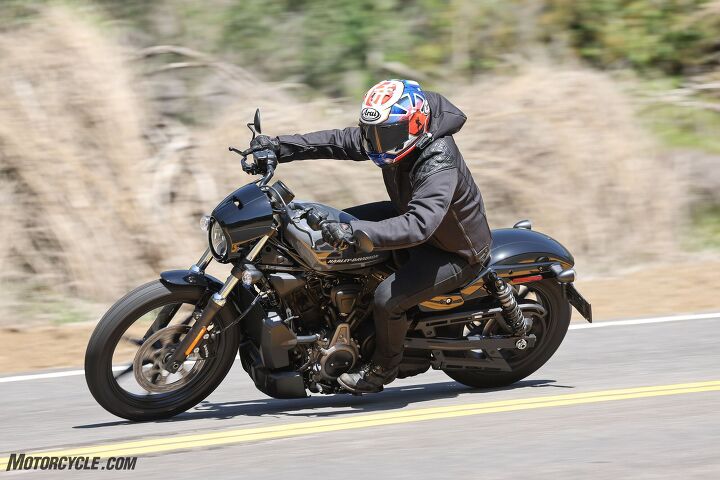
Noticing our grins intensifying as we filed back in from our photo runs, Harley-Davidson employees took note that we were really enjoying pushing these bikes at speeds we had not yet been able to. And then, by surprise, we were told once we were done that we could head back to the hotel. “Like, alone?” An immediacy took over the group to get the rest of our shooting done as efficiently and quickly as possible so we could get out for some proper testing.
Setting off to a heavenly set of twisty roads back to the coast, it was more of the same. Revving out the motor near redline brings with it a symphony of sounds that hasn’t yet come from a Nightster. It has just enough Harley-Davidson to it to remind you, but this crescendo builds to a fully modern melody, and if you swapped out that big ol’ single-side exhaust for something more free flowing, I’m sure it’s even better.
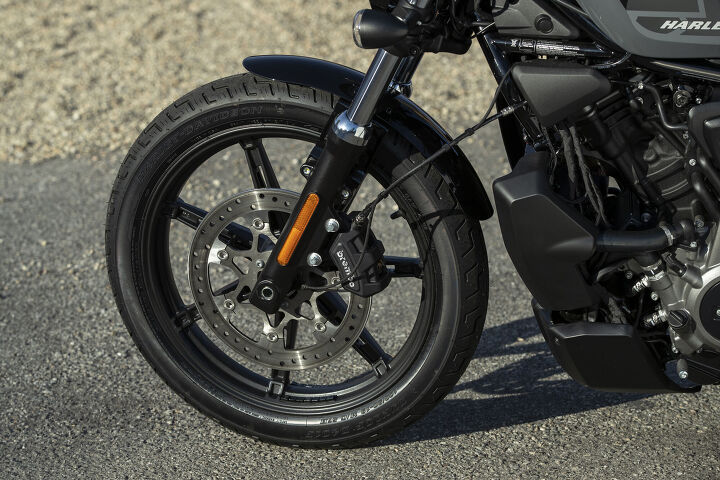
Turns out, that’s all you need to get the Nightster stopped quickly.
The single front rotor did an admirable job of slowing the Nightster down and provided pretty excellent feedback while the rear brake’s pedal was easy to modulate when looking to tighten up in a corner. Gone are the days where riding a Sporster quick was about getting up to speed and maintaining it as long as possible to get your kicks. Now, it’s easy to pull the throttle to its electronic stops as you slingshot toward the next corner, dig into the brakes, and trail off into the apex just as you wind back into the Nightster’s power curve toward the next one. I’ve never had that much fun on a cruiser.
Form follows function, but both report to emotion
“The days of cruiser customers being content with low and slow are gone,” Brad Richards tells us, “People expect more dynamic performance out of their motorcycles these days.” Given the direction we seem to be headed with these three new Rev Max-powered machines, and even the new ST models, it seems Harley is finally putting its engineering muscle to work in delivering the modern, capable machines most of us knew they could build.
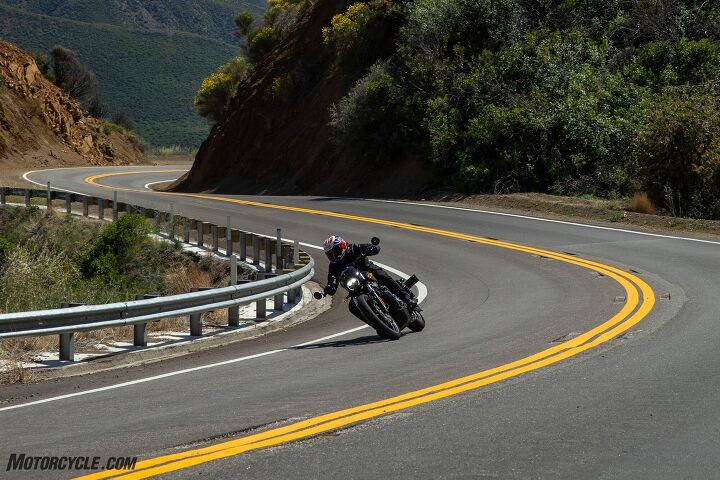
If you go to Harley-Davidson’s website you’ll find the Sportster S and Nightster under the “Sport” heading whereas the previous gen Sportsters – the Iron 883 and 1200cc Forty-Eight – can be found under the cruiser tab. When asked what the future holds for those cruisers we got the always-expected, “We can’t speak to future products.” Who knows, if those are the bikes you’re into, time may be limited to get a hold of one. Of course, that’s what the folks in Milwaukee would like you to think, whether it’s true or not.
After reading what could be confused for the same review from John Burns after his time spent on the Indian Scout Rogue (and on the same roads even), I think we’re going to have to get these two machines back out to Highway 33 to see how things shake out. All of a sudden the middleweight cruiser wars have reignited.
| 2022 Harley-Davidson Nightster Specifications | |
|---|---|
| Engine Type | Liquid-cooled Revolution Max 975T Chain-driven, DOHC, hydraulic self-adjusting lifters, intake VVT; four valves per cylinder |
| Bore | 3.82 in. (97 mm) |
| Stroke | 2.6 in. (66 mm) |
| Displacement | 59.5 cu in (975 cc) |
| Compression Ratio | 12:1 |
| Power | 90 hp at 7,500 rpm (claimed) |
| Torque | 70 lb-ft. at 5,000 rpm (claimed) |
| Fuel System | Electronic Sequential Port Fuel Injection (ESPFI) |
| Air Cleaner | Downdraft intake, tuned velocity stacks, washable filter media |
| Exhaust | 2-into-1; catalyst in header |
| Lubrication System | Semi-Dry Sump |
| Primary Drive | Gear, 49/89 ratio |
| Final Drive | Belt, 80/34 ratio |
| Clutch | Mechanical, 8 plate wet, assist & slip, 1090N |
| Transmission | 6-speed |
| Gear Ratios (overall) 1st | 12.21 |
| Gear Ratios (overall) 2nd | 9.022 |
| Gear Ratios (overall) 3rd | 6.994 |
| Gear Ratios (overall) 4th | 5.641 |
| Gear Ratios (overall) 5th | 4.731 |
| Gear Ratios (overall) 6th | 4.131 |
| Frame | Stressed-member, high strength low alloy steel trellis frame; stamped, cast, and forged junctions; MIG welded; aluminum forged mid-structure |
| Swingarm | Mild steel, rectangular tube section, stamped x-member; MIG welded |
| Front Fork | 41mm Showa Dual Bending Valve conventional forks. Aluminum fork triple clamps. 4.5 inches of travel |
| Rear Shocks | Rear suspension is dual outboard, direct-acting (no linkage) emulsion technology shock absorbers with coil springs and a threaded collar for pre-load adjustment. 3.0 inches of travel |
| Front Wheel | 19-inch aluminum cast, satin black, 2.5 inches wide |
| Rear Wheel | 16-inch aluminum cast, satin black, 4.25 inches wide |
| Front Brakes | Axially mounted 4-piston caliper, single 320mm disc |
| Rear Brakes | Floating single-piston caliper Solid uniform expansion rotor, 260mm disc |
| Brakes, Anti-Lock Braking System (ABS) | Standard |
| Tires | Dunlop Harley-Davidson Series Bias Blackwall |
| Front Tire | D401F 100/90-19 57H |
| Rear Tire | D401T 150/80B16 77H |
| Rake (Steering Head) | 30° |
| Fork Angle | 28° |
| Trail | 5.4 in. (137 mm) |
| Length | 86.9 in. (2,206 mm) |
| Overall Width | 32.9 in. (836 mm) |
| Overall Height | 43.6 in. (1,108 mm) |
| Seat Height, Laden | 27.1 in. (688 mm) |
| Seat Height, Unladen | 27.8 in. (705 mm) |
| Wheelbase | 61.3 in. (1,556 mm) |
| Fuel Capacity | 3.1 gal. (11.7 l) |
| Oil Capacity (w/filter) | 4.75 qt. (4.5 l) |
| Coolant Capacity | 2.22 qt. (2.1 l) |
| Weight, As Shipped | 462 lb. (210 kg) |
| Weight, In Running Order | 481 lb. (218 kg) |
| Gross Vehicle Weight Rating | 922 lb. (418 kg) |
| Gross Axle Weight Rating, Front | 353 lb. (160 kg) |
| Gross Axle Weight Rating, Rear | 595 lb. (270 kg) |
| Lean Angle | 32 degrees left and right |
| Fuel Economy | 52.4 mpg (claimed) |
| Battery | Sealed, maintenance-free, absorbed glass mat (AGM) battery, 12V, 12Ah, 225 CCA at 0°F |
| Charging | Three-phase, 45 Amp system (300 Watts @13 Volts, 1200 rpm, 585 Watts max power @ 13 Volts, 2250 rpm) |
| Starting | 0.9 kW electric with direct drive starter motor engagement |
| Headlight | All LED headlamp, low and high beam with signature position lighting |
| Rear Lights | All LED rear lighting |
| Front Signal Lights | LED Bullet Turn Signals |
| Rear Turn Signals | LED Bullet Turn Signals |
| Gauges | 4-inch viewable round gauge area analog display with, Speedometer, L/R turn Indication, Traction Control Indication, Coolant Temperature Alert, ABS alert, Fog Lamp Indication, Battery Voltage Alert, High Beam Indicator, Low Fuel Indication, Rear-ABS Disabled Indication, Failure-Indication Alert, Neutral Position Indication, Low Tire Pressure indication, Check Engine Light indication, Oil Pressure Alert, Service Indication. |
| Warranty | 24 months (unlimited mileage) |
| Service Interval | First 1,000 miles (1,600 km), every 5,000 miles (8,000 km) thereafter |
We are committed to finding, researching, and recommending the best products. We earn commissions from purchases you make using the retail links in our product reviews. Learn more about how this works.
Become a Motorcycle.com insider. Get the latest motorcycle news first by subscribing to our newsletter here.
